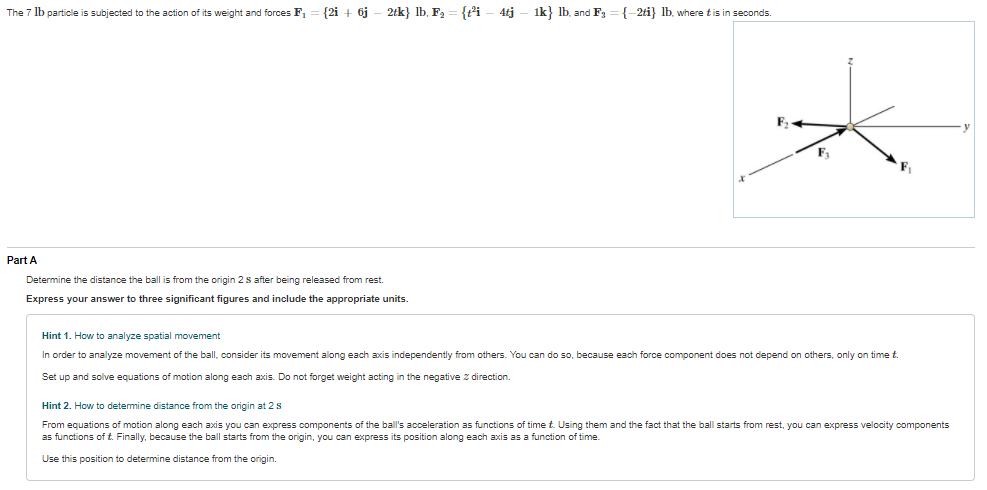The 7 lb particle is subjected to the action of its weight and forces F1 {2i + 6j 2tk} lb, F2 = {t°i – 4tj – 1k} lb. and F3 = {-2ti} lb. where tis in seconds. F3 Part A Determine the distance the ball is from the origin 2 s after being released from rest. Express your answer to three significant figures and include the appropriate units. Hint 1. How to analyze spatial movement In order to analyze movement of the ball, consider its movement along each axis independently from others. You can do so, because each force component does not depend on others, only on time t. Set up and solve equations of motion along each axis. Do not forget weight acting in the negative z direction. Hint 2. How to detemine distance from the origin at 2s From equations of motion along each axis you can express components of the ball's acceleration as functions of time t. Using them and the fact that the ball starts from rest, you can express velocity components as functions of t. Finally, because the ball starts from the origin, you can express its position along each axis as a function of time. Use this position to determine distance from the origin.
The 7 lb particle is subjected to the action of its weight and forces F1 {2i + 6j 2tk} lb, F2 = {t°i – 4tj – 1k} lb. and F3 = {-2ti} lb. where tis in seconds. F3 Part A Determine the distance the ball is from the origin 2 s after being released from rest. Express your answer to three significant figures and include the appropriate units. Hint 1. How to analyze spatial movement In order to analyze movement of the ball, consider its movement along each axis independently from others. You can do so, because each force component does not depend on others, only on time t. Set up and solve equations of motion along each axis. Do not forget weight acting in the negative z direction. Hint 2. How to detemine distance from the origin at 2s From equations of motion along each axis you can express components of the ball's acceleration as functions of time t. Using them and the fact that the ball starts from rest, you can express velocity components as functions of t. Finally, because the ball starts from the origin, you can express its position along each axis as a function of time. Use this position to determine distance from the origin.
Physics for Scientists and Engineers
10th Edition
ISBN:9781337553278
Author:Raymond A. Serway, John W. Jewett
Publisher:Raymond A. Serway, John W. Jewett
Chapter3: Vectors
Section: Chapter Questions
Problem 15P: The helicopter view in Fig. P3.15 shows two people pulling on a stubborn mule. The person on the...
Related questions
Topic Video
Question

Transcribed Image Text:The 7 lb particle is subjected to the action of its weight and forces F1
{2i + 6j
2tk} lb, F2 = {t°i – 4tj – 1k} lb. and F3 = {-2ti} lb. where tis in seconds.
F3
Part A
Determine the distance the ball is from the origin 2 s after being released from rest.
Express your answer to three significant figures and include the appropriate units.
Hint 1. How to analyze spatial movement
In order to analyze movement of the ball, consider its movement along each axis independently from others. You can do so, because each force component does not depend on others, only on time t.
Set up and solve equations of motion along each axis. Do not forget weight acting in the negative z direction.
Hint 2. How to detemine distance from the origin at 2s
From equations of motion along each axis you can express components of the ball's acceleration as functions of time t. Using them and the fact that the ball starts from rest, you can express velocity components
as functions of t. Finally, because the ball starts from the origin, you can express its position along each axis as a function of time.
Use this position to determine distance from the origin.
Expert Solution
This question has been solved!
Explore an expertly crafted, step-by-step solution for a thorough understanding of key concepts.
Step by step
Solved in 2 steps with 2 images

Knowledge Booster
Learn more about
Need a deep-dive on the concept behind this application? Look no further. Learn more about this topic, physics and related others by exploring similar questions and additional content below.Recommended textbooks for you

Physics for Scientists and Engineers
Physics
ISBN:
9781337553278
Author:
Raymond A. Serway, John W. Jewett
Publisher:
Cengage Learning

Physics for Scientists and Engineers with Modern …
Physics
ISBN:
9781337553292
Author:
Raymond A. Serway, John W. Jewett
Publisher:
Cengage Learning

College Physics
Physics
ISBN:
9781285737027
Author:
Raymond A. Serway, Chris Vuille
Publisher:
Cengage Learning

Physics for Scientists and Engineers
Physics
ISBN:
9781337553278
Author:
Raymond A. Serway, John W. Jewett
Publisher:
Cengage Learning

Physics for Scientists and Engineers with Modern …
Physics
ISBN:
9781337553292
Author:
Raymond A. Serway, John W. Jewett
Publisher:
Cengage Learning

College Physics
Physics
ISBN:
9781285737027
Author:
Raymond A. Serway, Chris Vuille
Publisher:
Cengage Learning

University Physics Volume 1
Physics
ISBN:
9781938168277
Author:
William Moebs, Samuel J. Ling, Jeff Sanny
Publisher:
OpenStax - Rice University

College Physics
Physics
ISBN:
9781305952300
Author:
Raymond A. Serway, Chris Vuille
Publisher:
Cengage Learning

Principles of Physics: A Calculus-Based Text
Physics
ISBN:
9781133104261
Author:
Raymond A. Serway, John W. Jewett
Publisher:
Cengage Learning